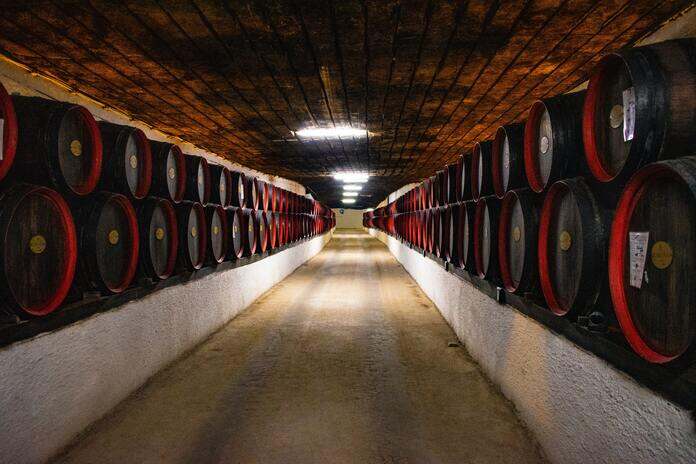Vintage Wine Estates (NASDAQ:VWE) has recently been a flop, with deteriorating gross margins and a management change that resulted in downward revisions from consensus projections, which really irritated Mr. Market, causing the shares to fall from $2.02 to $1.28 per share (at the time of this writing). For these reasons, I’m not bullish about VWE’s prospects unless they demonstrate significant changes in management and financial performance in the near future, which might restore investor trust and drive the stock price higher.
VWE Stock Price Change
I’d like to show you the stock’s price movement for perspective. VWE is currently down 86% year on year as of this writing. There must be something causing the price to fall from its 52-week high of $9.91 to its 52-week low of $0.96.
I suppose we could blame it on the epidemic, right? As a retailer, it would be natural for a company’s stock to fall due to fewer sales during the epidemic. VWE, on the other hand, increased its yearly revenue from $189.92 million in 2020 to $220.74 million in 2021, a 16.23% increase. Not a bad epidemic run for VWE, eh? Surely it isn’t the result of poor inventory management, downward revisions, low investor confidence, a change in management, or late filing of quarterly reports, right (it was)?
Why I’m Not Too Certain
This is why I’m not very optimistic about VWE. Sure, its revenue growth year over year is far higher than the sector average, but it is these aspects that make me less confident in VWE. Specifically, its poor inventory management produced a significant drop in its stock price in September of 2022, as its abrupt management transition, affected reduced management forecast, resulting in underperformance once again, and the company’s delayed quarterly report timings.
When you think about it, these concerns point to deeper underlying issues inside the company’s operations and decision-making processes. Regaining investor trust and improving the company’s performance will need tremendous effort and strategic improvements.
The issues are fundamental; inadequate inventory management results in huge write-offs, which can impair the company’s profitability. One of the key causes for this huge price decline was inadequate inventory management.
There is also a problem with the company’s shift to a new management line. Pat Roney, the current CEO, and founder, will be promoted to executive chairman from his existing position, and a search for a replacement will begin with the current director, John Moramarco, serving as interim CEO. What can we expect here? My best estimate is that the vision will remain the same with Pat Roney as executive chairman. With its sole focus on “producing the finest quality wines and incredible customer experiences,” I don’t expect the company to lose sight of its purpose; nevertheless, changing management can lead to inconsistencies, which investors should be aware of.
Personally, I believe that the change of guidance due to “mis-clarification and accounting for certain assets, as well as the timing of recording certain costs” is a good move because prospective investors and current holders will welcome openness, which is the first step toward establishing trust. The restated figures are likely to show a $700,000 gain in net revenue but a stunning $2.9 million increase in COGS, resulting in a $0.02 decrease in EPS to $0.00. Furthermore, the company offered a reduced projection of $81 million in the second quarter, below the consensus of $86 million, and a 35% gross margin, considerably below the 43% analyst expectations.
There’s also a small issue with the VWE’s late quarterly report submission. Sure, this warning has no “impact on the listing or trading of the stock,” but it raises a moral question for me. How can an investor trust them with their money if even the fundamentals aren’t addressed (misclassifications, accounting problems, etc.)? Some would call this recklessness and a (possible) empire constructed on a weak footing.
Transparency and accountability are critical for businesses, especially when it comes to financial reporting. As an investor, it is critical to evaluate these issues before making any investment decisions, which is why I am not overly optimistic about VWE at the moment. As a result, I believe VWE is a good investment.
The Right Steps Have Been Taken
VWE has taken initiatives to raise annualized earnings by approximately $10 million through a combination of price increases, cost recovery methods, and expense reductions to date. This seems really promising, but it’s one of those “see-to-believe” situations. If I don’t see early indicators of dependability, I don’t think VWE will be able to persuade me or anybody else. VWE has strategically increased prices across the Direct to Consumer (DTC) segment (which could be good if their customers rave about it and really enjoy their products, in which case a price increase wouldn’t matter), is taking pricing on select wholesale brands, increased DTC shipping fees by an average of more than 50%, and restructured a B2B customer contract to lower freight costs. Again, these adjustments seem positive, but without a strong demonstration of good implementation, plans remain plans.
It has also lowered its full-time headcount by roughly 4%, which is usual if the company intends to lay off some employees in order to save money. The plan’s estimated $2 million execution costs will be recorded during the third quarter of fiscal 2023, so to summarize, the company is in the process of developing a comprehensive business development and restructuring plan that will evaluate a number of options for additional cost savings, such as customer contract renegotiations, business simplification, a focus on key brands, and SKU (stock keeping unit) reductions, at a cost of $2 million. I mean, okay, a $2 million upfront expenditure might disturb the near-term price action, but if it’s an expense the VWE is ready to spend to boost its annualized earnings, I’m all in.
Takeaway for Investors
Overall, it’s evident that VWE is in trouble, and it all boils down to how much an investor can bear in the short run. I say near-term headwinds because if the company can maintain strong top-line growth while addressing management concerns and attempting to increase annual profitability, things can quickly deteriorate. The $1.28 share price may be appealing from a momentum standpoint and in comparison to its present pricing. Again, it all comes down to how much an investor can endure in the short run given the company’s lackluster execution; if they manage to pull off all of their goals and get their act together, my narrative on VWE will change. For the time being, considering the company’s poor inventory management, management changes, VWE’s responsibility issue, and likely margin decline, I’m hesitant to proceed with VWE. Sure, the low price is appealing, but the uncertainty and danger exceed the benefit, which is not really valuable. I wouldn’t want to be trapped in HOFDL [hanging on for dear life] looking for a bottom with this stock.
Featured Image: Pexels @ Ion Ceban @ionelceb









